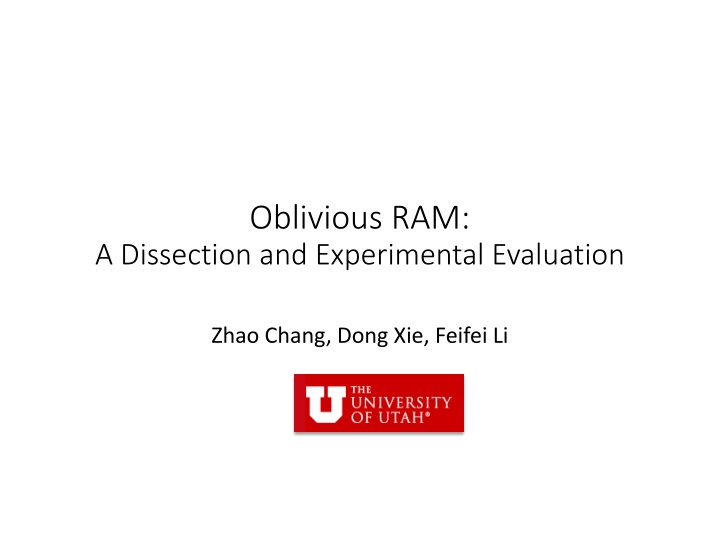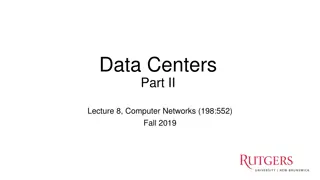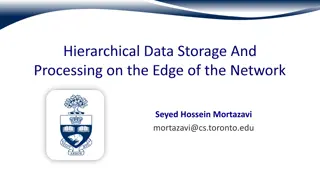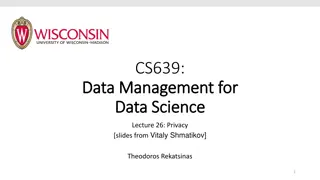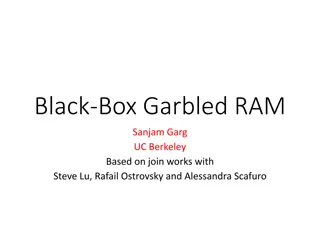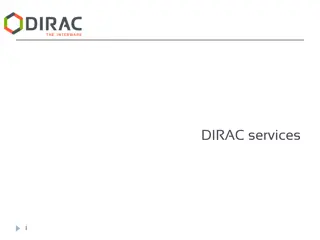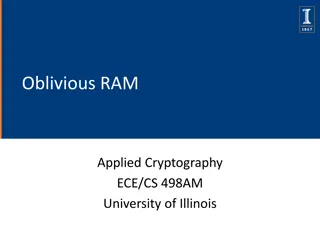Oblivious RAM: Enhancing Data Privacy in Cloud Computing
Introduction to Oblivious RAM (ORAM), a technique that aims to hide both data content and access patterns in cloud computing environments. ORAM addresses security concerns related to using public cloud services by ensuring that any two access patterns of the same length are indistinguishable. The model, threat analysis, and construction methods of ORAM are explored, highlighting its potential to enhance data privacy and security in cloud storage.
Download Presentation

Please find below an Image/Link to download the presentation.
The content on the website is provided AS IS for your information and personal use only. It may not be sold, licensed, or shared on other websites without obtaining consent from the author.If you encounter any issues during the download, it is possible that the publisher has removed the file from their server.
You are allowed to download the files provided on this website for personal or commercial use, subject to the condition that they are used lawfully. All files are the property of their respective owners.
The content on the website is provided AS IS for your information and personal use only. It may not be sold, licensed, or shared on other websites without obtaining consent from the author.
E N D
Presentation Transcript
Oblivious RAM: A Dissection and Experimental Evaluation Zhao Chang, Dong Xie, Feifei Li
Introduction A lot of big data Rise of cloud computing Pay-as-you-go model for public clouds Outsourced data storage Security concerns behind outsourcing data to public clouds
Introduction Possible solutions? Use trusted public cloud services (Google is not evil) Use private cloud infrastructure (Walmart uses OpenStack) Use encryption, however
Introduction Only hiding the content is not enough E.g. In an online health application, when the user selects a health condition from a list, the server would send back an updated web page with information on that illness. By learning the size of the page or file access pattern for each health condition, they could determine which conditions a user had without seeing any data (even if encrypted). Is there a way to hide how we access our data but still use public cloud infrastructure? Answer: Oblivious RAM
Introduction Lots of literatures have been published since 1987. Challenge: choose and use ORAM in applications Theoretical interest vs. Practical usage Have not been thoroughly compared Lack of open sourced implementation
Oblivious RAM: Model Data are stored in atomic units, referred as blocks. Each block has an unique ID, Block + ID = Item Capacity : the total number of items that an OS instance needs to support. Server : a general key-value storage service supports: ??? ? , ???(?,?) : get/put a value to a specific key ???????? ?1,?2,? : return the first p items with keys in range [?1,?2] ????????(?1,?2) : remove all items with keys within range [?1,?2] Client : Holds a small amount of private memory (either ?(?) or ?(?)) User can pose ??? ? and ???(?,?) to the client to access her data
Oblivious RAM: Threat Model Objective: hide both data content and access pattern Any two access patterns of the same length are computational indistinguishable by anyone other than the client. Adversary: cloud server The server is curious but not malicious Curious: wish to learn sensitive info of the client Not malicious: will honestly do that it is supposed to do
Square-Root Construction Item ( ?? ,????(?,?)) Dummy Item ID 1, , ? Server ? + ? items = ? original items + ? dummy items Dummy counter: ? Client ? items
Square-Root Construction (contd) Found in cache? ???(?)/???(?,?) Not found! Server ???( ?(?)) append returned item to cache ???/?????? item in cache Client
Square-Root Construction (contd) Found in cache? ???(?)/???(?,?) Found! Server ++?,???( ?( ?)) Append returned item to cache Client ???/?????? item in cache
Square-Root Construction (contd) Cache is full! Do an oblivious shuffle over all server items Server put items back to server Clear cache Client Block request from clients Possible options for oblivious shuffle: K. E. Batcher. Sorting networks and their applications. In AFIPS Spring Joint Computing Conference, pages 370 314, 1968 D. Xie, G. Li, B. Yao, X. Wei, X. Xiao, Y. Gao, and M. Guo. Practical private shortest path computation based on oblivious storage. In ICDE, 2016.
?(1) Private Memory? Use ?( ?) server storage (shelter)as the cache Scan all the items to perform read/update in the cache Server Client O(1) Square Root Construction: O. Goldreich. Towards a theory of software protection and simulation by oblivious RAMs. In STOC, pages 182 194, 1987
Hierarchical ORAM Construction Use Hierarchy of Buffers (hash tables) of different sizes Server: log N levels for N items. Level i contains 2i buckets. Each bucket contains log N slots. Client: PRP key Ki for each level. PRP Keys 1 K1 2 K2 = data K3 3 K4 4 O. Goldreich and R. Ostrovsky. Software protection and simulation on oblivious RAMs. Journal of the ACM, 43(3), 1996.
Hierarchical ORAM Construction (contd) Read/Write(addr) At level ?, scan exactly one bucket Until found, scan bucket at F(Ki, addr) After found, scan a random bucket Write data into bucket F(K1, addr) on level 1. Check if an overflow is occurred. Overflow: #data > ? in level ?. PRP Keys 1 K1 2 K2 = data K3 3 K4 4 O. Goldreich and R. Ostrovsky. Software protection and simulation on oblivious RAMs. Journal of the ACM, 43(3), 1996.
Hierarchical ORAM Construction (contd) When level i overflows: pick new PRP key for levels i and i+1, then shuffle data in levels i and i+1 together into level i+1 using new key Algorithm: Oblivious hashing* Aim: Hash keys into buckets. The advisory cannot get information about the load factor of each bucket and the mapping between keys and buckets. Shuffle buffers with frequency inversely proportional to their sizes Level i is shuffled after every 2i ops. *: Ostrovsky, Rafail. "Efficient computation on oblivious RAMs." Proceedings of the twenty-second annual ACM symposium on Theory of computing. ACM, 1990.
Partition ORAM Subdivide the O-RAM into much smaller partitions the operations performed on the partitions can be handled much more efficiently. Each partition is a full functional ORAM scheme Stefanov, Emil, Elaine Shi, and Dawn Song. "Towards practical oblivious RAM. arXiv preprint arXiv:1106.3652 (2011).
Partition ORAM (contd) Position map to track which partition each item resides in Cache read/updated blocks in a random partition s cache slot Evict items in cache slots periodically to its ORAM partition Stefanov, Emil, Elaine Shi, and Dawn Song. "Towards practical oblivious RAM. arXiv preprint arXiv:1106.3652 (2011).
Tree-Based ORAM Organize data blocks on the server as a full binary tree (log? levels, ? leaf nodes). Each node in the tree is a bucket of ? items Each item is assigned to a random leaf node of the tree. There is a position map to track which leaf node is assigned to a data item. ? leaf nodes log? levels Server Client stash posMap
Tree-Based ORAM (contd) Basic invariant: Item ? must resides in the path starting from the tree root to leaf node ??????[?]. Retrieve the whole path that may contain the item and push all items on the path in client s private stash Try to put items in the stash back to the tree while keep the basic invariant ? leaf nodes log? levels Server Client stash posMap
Recursion Size of position map: ?(??), may not affordable even though ? is small Store the position map in another ORAM. Do this recursively. O-RAM #2: Position Map for O-RAM #1 O-RAM #1 O-RAM #3: Position Map for O-RAM #2 Server Client
Performance Evaluation Two machines: client and server Client: 6GB main memory Server: 95GB main memory and 1TB hard disk Connected by 1Gbps Ethernet Storage engine: MongoDB on the server AES encryption + SHA2 hash provided by CryptoPP Implement different ORAM schemes in a unified testbed.
Conclusion Made a comprehensive survey on different ORAM constructions and principles. Implement different ORAM schemes in a unified testbed, and optimize them with respect to efficiency, scalability, and communication cost. Perform extensive experiments on large data to compare the performance of various ORAM constructions. Report insights gained from the experimental results, which exposes the strength and weakness of different existing ORAMs, and provides guidelines on selecting a suitable construction under different scenarios Our testbed is now open sourced at: https://github.com/InitialDLab/SEAL-ORAM
